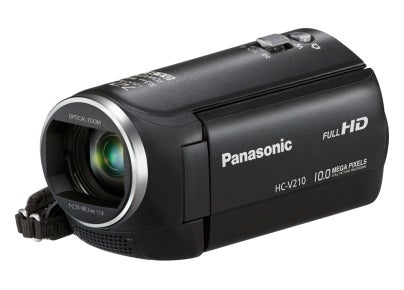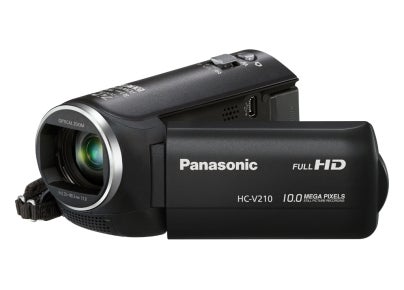Panasonic HC-V210 Review
Panasonic HC-V210
A £200 camcorder with features nicked from the top models.

Sections
- Page 1 Panasonic HC-V210 Review
- Page 2 Manual Settings, Image Quality and Verdict Review
Verdict
Pros
- Good image quality
- Keen price
- Capable optical image stabilisation
Cons
- No WiFi features
- SD card slot on base of unit
- Mediocre still image abilities
Key Specifications
- Review Price: £191.72
- 1/5.8in BSI CMOS with 2.51Mpixels
- 42x optical zoom; 72x Intelligent Zoom
- Power OIS with Active Mode
- 1080/50p AVCHD 2.0 format at up to 28Mbits/sec
- Manual focus, shutter, iris and white balance
What is the Panasonic HC-V210?
The Panasonic HC-V210 is a budget HD camcorder with more manual features than you might expect for the price and size.
There has been discussion about whether camcorders are really worth buying these days, especially at the budget end of the market. With compact digital cameras and smartphones offering quite passable video recording now, there are increasingly good reasons why you shouldn’t bother with a camcorder unless you are a videomaking enthusiast. So Panasonic’s budget-priced HC-V210 has a lot to prove to justify its existence.
Panasonic HC-V210 – Features
Things get off to a reasonable start with the basic specification. This sub-£200 model uses the same 1/5.8-inch CMOS sensor as the higher-end HC-V520, with back-side illumination (BSI) and a gross 2.51Mpixels, of which 2.2Mpixels are used when shooting. This is more than enough for Full HD, and bodes well for image detail, while the BSI technology should help boost performance in low light.
The Panasonic V210 also punches way ahead of the non-camcorder competition for zoom factor, too. The basic optical zoom is 42x, which can be increased to 72x in i.Zoom mode, although this kind of zoom usually takes advantage of spare pixels, which the V210 doesn’t have. But even the 42x optical zoom is about twice what the best compact super-zoom digital cameras offer.
Probably the most impressive inclusion for a camcorder at this price, however, is the optical image stabilisation. This is something very few phones have, and is often missing when shooting video on a compact camera. The stabilisation comes in the form of Panasonic’s Power OIS, rather than the more capable Hybrid OIS found in the HC-V520 and above. It also lacks the OIS Lock and Level Shot functions, but Active Mode is still in evidence.
The single SD card slot on the bottom of the Panasonic HC-V210 is used exclusively for recording, as there is no memory built-in. This is not the best location for the slot, as if you do happen to be using a tripod and want to change memory cards, you will need to take off your tripod’s quick release plate. Admittedly, though, this is probably not the kind of camcorder you would use regularly on a tripod.
The Panasonic V210 records in the AVCHD 2.0 format, so provides quality modes up to Full HD at 50 progressive frames per second and a 28Mbits per second data rate. There is also an MP4-based iFrame option which uses 28Mbits per second but a resolution of 960 x 540, plus a 640 x 360 mode with a miserly 1.5Mbits per second aimed at internet usage.
At the top 28Mbits per second setting, a 16GB SD card will be enough for around 76 minutes of footage. It’s also possible to take 10-megapixel still images with the V210, at a resolution of 4,224 x 2,376. You can’t grab stills when recording video, though, and with only 2.2Mpixels of the sensor used when shooting stills, the images will involve interpolation.


